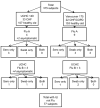Clinical and immunologic predictors of influenza illness among vaccinated older adults
- PMID: 20646987
- PMCID: PMC2948951
- DOI: 10.1016/j.vaccine.2010.07.036
Clinical and immunologic predictors of influenza illness among vaccinated older adults
Abstract
The diagnosis of influenza is often missed in older adults and illness presentation may be modified by prior vaccination. We evaluated the symptoms and immunologic markers predicting laboratory-confirmed influenza (LCI) among vaccinated older adults. In subjects with influenza-like illness (ILI), fever distinguished subjects with laboratory-confirmed influenza (LCI) from those with other ILI (39% vs. 12.5%, p=0.009). In LCI subjects who did not seroconvert to influenza infection, pre-infection levels of the cytolytic mediator, granzyme B, correlated with fever (r=1.000; p=0.01) and the IFN-gamma:IL-10 ratio (r=0.999; p=0.03), and increased following influenza infection in LCI vs. ILI subjects (p=0.03). The cell-mediated immune response to influenza distinguishes A/H3N2 LCI from other ILI in older adults, and suggests a link between cell-mediated immunity and influenza illness severity in vaccinated older adults.
(c) 2010 Elsevier Ltd. All rights reserved.
Conflict of interest statement
Conflict of interest: Dr. McEhaney has received funding for this study under an investigated-initiated research contract with GSK. She has also received funding for the following (alphabetical order): CSL (honoraria), Dynavax (honoraria), GSK (consultancy, honoraria and research funding), Merck (consultancy, honoraria, participation in clinical research study and trial), Novartis (honoraria), Novavax (consultancy), Sanofi Pasteur (consultancy and honoraria), and Solvay (consultancy and honoraria).
Figures




Similar articles
-
Cellular immune responses of older adults to four influenza vaccines: Results of a randomized, controlled comparison.Hum Vaccin Immunother. 2017 Sep 2;13(9):2048-2057. doi: 10.1080/21645515.2017.1337615. Epub 2017 Jun 21. Hum Vaccin Immunother. 2017. PMID: 28635557 Free PMC article. Clinical Trial.
-
T cell responses are better correlates of vaccine protection in the elderly.J Immunol. 2006 May 15;176(10):6333-9. doi: 10.4049/jimmunol.176.10.6333. J Immunol. 2006. PMID: 16670345
-
Correlation of cellular immune responses with protection against culture-confirmed influenza virus in young children.Clin Vaccine Immunol. 2008 Jul;15(7):1042-53. doi: 10.1128/CVI.00397-07. Epub 2008 Apr 30. Clin Vaccine Immunol. 2008. PMID: 18448618 Free PMC article. Clinical Trial.
-
A randomized clinical trial of the impact of melatonin on influenza vaccine: Outcomes from the melatonin and vaccine response immunity and chronobiology study (MAVRICS).Hum Vaccin Immunother. 2024 Dec 31;20(1):2419742. doi: 10.1080/21645515.2024.2419742. Epub 2024 Nov 13. Hum Vaccin Immunother. 2024. PMID: 39539030 Free PMC article. Clinical Trial.
-
Cellular Interferon Gamma and Granzyme B Responses to Cytomegalovirus-pp65 and Influenza N1 Are Positively Associated in Elderly.Viral Immunol. 2016 Apr;29(3):169-75. doi: 10.1089/vim.2015.0071. Epub 2016 Mar 22. Viral Immunol. 2016. PMID: 27002465 Free PMC article.
Cited by
-
Immune Checkpoint Function of CD85j in CD8 T Cell Differentiation and Aging.Front Immunol. 2017 Jun 14;8:692. doi: 10.3389/fimmu.2017.00692. eCollection 2017. Front Immunol. 2017. PMID: 28659925 Free PMC article.
-
Cytomegalovirus Seropositivity Predicts a Decline in the T Cell But Not the Antibody Response to Influenza in Vaccinated Older Adults Independent of Type 2 Diabetes Status.J Gerontol A Biol Sci Med Sci. 2017 Sep 1;72(9):1163-1170. doi: 10.1093/gerona/glw216. J Gerontol A Biol Sci Med Sci. 2017. PMID: 27789617 Free PMC article.
-
How can Biology of Aging Explain the Severity of COVID-19 in Older Adults.Clin Geriatr Med. 2022 Aug;38(3):461-472. doi: 10.1016/j.cger.2022.04.002. Epub 2022 Apr 22. Clin Geriatr Med. 2022. PMID: 35868666 Free PMC article. Review.
-
Parameters of the Immune System and Vitamin D Levels in Old Individuals.Front Immunol. 2018 May 24;9:1122. doi: 10.3389/fimmu.2018.01122. eCollection 2018. Front Immunol. 2018. PMID: 29910802 Free PMC article.
-
Vaccination of older adults: Influenza, pneumococcal disease, herpes zoster, COVID-19 and beyond.Immun Ageing. 2021 Oct 9;18(1):38. doi: 10.1186/s12979-021-00249-6. Immun Ageing. 2021. PMID: 34627326 Free PMC article. Review.
References
-
- Thompson WW, Shay DK, Weintraub E, Brammer L, Cox N, Anderson LJ, et al. Mortality associated with influenza and respiratory syncytial virus in the United States. Jama. 2003;289(2):179–86. - PubMed
-
- Thompson WW, Shay DK, Weintraub E, Brammer L, Bridges CB, Cox NJ, et al. Influenza-associated hospitalizations in the United States. Jama. 2004;292(11):1333–40. - PubMed
-
- Glezen WP. Serious morbidity and mortality associated with influenza epidemics. Epidemiol Rev. 1982;4:25–44. - PubMed
-
- Carrat F, Tachet A, Rouzioux C, Housset B, Valleron AJ. Evaluation of clinical case definitions of influenza: detailed investigation of patients during the 1995–1996 epidemic in France. Clin Infect Dis. 1999;28(2):283–90. - PubMed
Publication types
MeSH terms
Substances
Grants and funding
LinkOut - more resources
Full Text Sources
Medical

